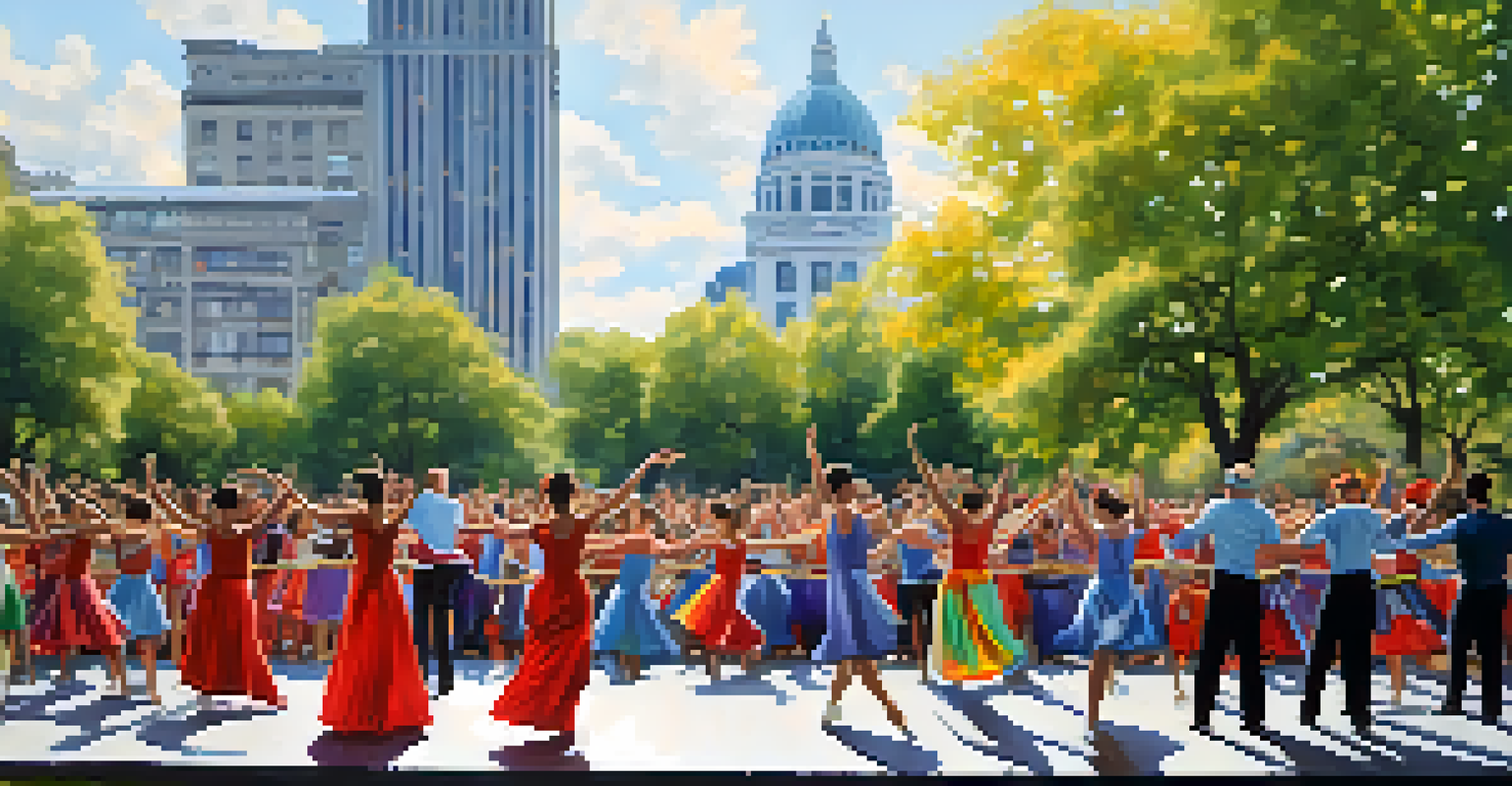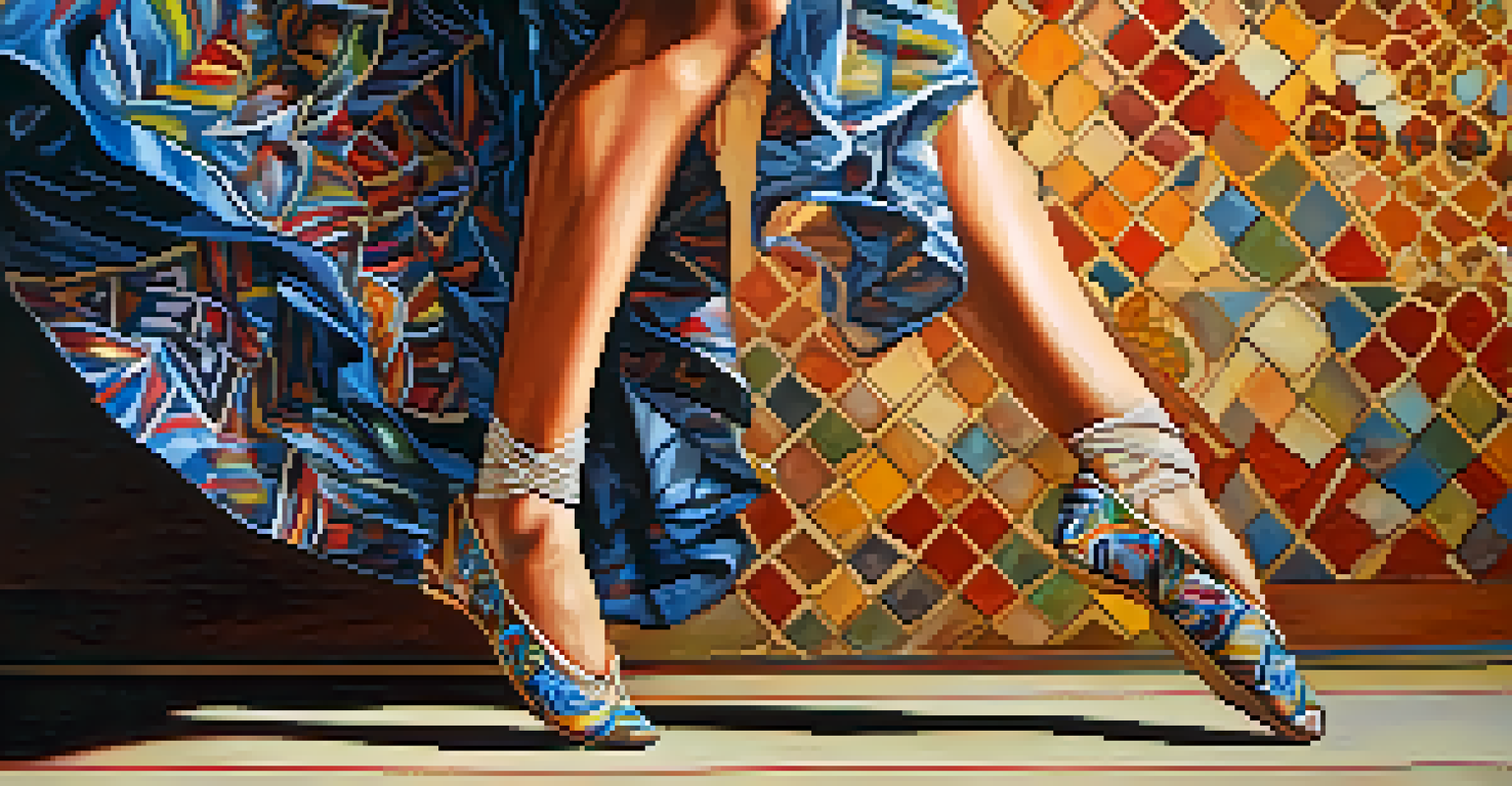Breaking Stereotypes: Dance as a Form of Individual Expression

Understanding Dance as a Universal Language
Dance transcends linguistic barriers, making it a universal form of expression. It allows individuals to communicate emotions and stories without uttering a single word. From ballet to hip-hop, every dance style has its own unique vocabulary, inviting people from all walks of life to share in the experience.
Dance is the hidden language of the soul.
For many, dance becomes a canvas where emotions paint vivid pictures of joy, sorrow, or rebellion. Just as an artist uses colors to convey feelings, dancers use movement to express their innermost thoughts. This shared experience fosters connection and understanding among diverse cultures.
In this way, dance serves as a bridge between individuals, encouraging empathy and appreciation for different backgrounds. It dismantles stereotypes by showcasing the richness of human emotion and expression, proving that everyone has a story worth sharing.
Challenging Gender Norms Through Dance
Traditionally, dance has often been categorized by gender, with certain styles considered 'masculine' or 'feminine.' However, many dancers are breaking these stereotypes, proving that anyone can excel in any style regardless of gender. This shift is empowering individuals to embrace their unique identities.

For instance, male dancers in ballet are increasingly celebrated, showcasing their strength and agility. Likewise, women are making their mark in hip-hop and breakdancing, challenging outdated perceptions of grace and power. This blending of styles encourages others to explore their passions without fear of judgment.
Dance as a Universal Expression
Dance transcends language barriers, allowing individuals to communicate emotions and stories without words.
As more dancers challenge these norms, the dance community becomes a more inclusive space. It inspires others to express themselves freely, reinforcing the idea that dance is for everyone, regardless of gender roles or expectations.
Dance as a Tool for Cultural Expression
Every culture has its own dance forms that reflect its history, values, and traditions. From traditional folk dances to contemporary fusion styles, dance serves as a powerful medium for cultural expression. This diversity enriches the global dance landscape, inviting everyone to learn from one another.
The dance is a poem of which each movement is a word.
By participating in or observing various dance forms, individuals gain insights into different cultures and experiences. This exposure fosters appreciation and respect, breaking down stereotypes associated with cultural misunderstandings. For example, learning a traditional dance can provide a deeper understanding of its cultural significance.
Moreover, as dancers incorporate their cultural backgrounds into their work, they create a space for dialogue and exchange. This not only preserves cultural heritage but also encourages innovation, as new styles emerge from the blending of different traditions.
The Healing Power of Dance
Dance can also be a therapeutic outlet for many individuals. The act of moving can release pent-up emotions, reduce stress, and even promote physical well-being. For those who struggle to express themselves verbally, dance offers an alternative means of communication.
Various therapeutic dance programs have emerged, focusing on healing through movement. Participants often find that dancing helps them process trauma, build self-esteem, and foster a sense of community. This healing aspect of dance breaks stereotypes about mental health, demonstrating that vulnerability can lead to strength.
Challenging Gender Stereotypes
Dancers are breaking traditional gender norms, demonstrating that anyone can excel in any style regardless of gender.
As individuals find solace in dance, they embrace their unique journeys, reinforcing the idea that expression is personal and varied. This reinforces the belief that no matter what challenges arise, dance can serve as a source of comfort and empowerment.
Dance as a Form of Political Expression
Throughout history, dance has been used as a form of political expression and activism. From protest performances to flash mobs, dance can communicate messages of resistance, solidarity, and change. It serves as a powerful tool for raising awareness about social issues, encouraging people to take action.
For example, the dance movement 'Black Lives Matter' has used choreography to highlight racial injustice and promote unity. These performances often resonate deeply with audiences, sparking conversations and inspiring change. By using their bodies as instruments of expression, dancers challenge societal norms and provoke thought.
This political aspect of dance emphasizes its role in shaping public discourse. It illustrates that art, in any form, can be a catalyst for dialogue and transformation, breaking stereotypes about the limitations of creative expression.
The Evolution of Dance Styles and Influences
The evolution of dance styles reflects the dynamic nature of culture and society. As global influences intertwine, new dance forms emerge, breaking the mold of traditional styles. This evolution invites dancers to explore, innovate, and express themselves in ways that resonate with their identities.
For instance, styles like contemporary dance have integrated elements of various genres, blurring the lines between ballet, jazz, and street dance. This fusion creates a rich tapestry of movement that reflects the complexities of modern life. Dancers are encouraged to draw inspiration from diverse influences, expanding their creative horizons.
Dance as Cultural and Political Voice
Dance serves as a powerful tool for cultural expression and political activism, fostering dialogue and challenging societal norms.
By embracing this evolution, dancers challenge the notion that certain styles belong to specific groups. Instead, they celebrate the idea that dance is a fluid, ever-changing art form that welcomes all forms of expression, encouraging individuality and creativity.
Empowering the Next Generation of Dancers
As society becomes more accepting of diverse expressions, the next generation of dancers is empowered to embrace their uniqueness. Dance studios and programs now emphasize individuality, encouraging young dancers to explore their styles and narratives. This shift fosters a sense of confidence and authenticity in aspiring performers.
Mentorship programs and community initiatives are also vital in nurturing new talent. Experienced dancers share their journeys, inspiring youth to break free from stereotypes and embrace their identities. This guidance helps cultivate an inclusive environment where creativity flourishes.

By empowering young dancers, we create a future where expression knows no bounds. This next generation is poised to continue challenging societal norms, ensuring that dance remains a vibrant and diverse form of individual expression for years to come.